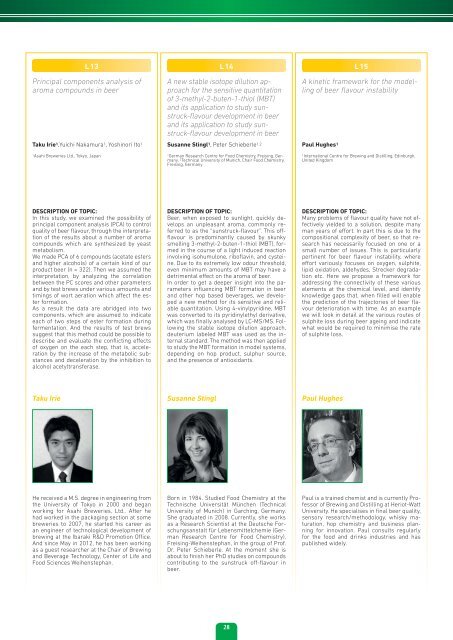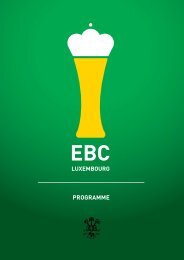please click here for download. - the 34th European Brewery ...
please click here for download. - the 34th European Brewery ...
please click here for download. - the 34th European Brewery ...
Create successful ePaper yourself
Turn your PDF publications into a flip-book with our unique Google optimized e-Paper software.
L 13<br />
Principal components analysis of<br />
aroma compounds in beer<br />
Taku Irie 1 ,Yuichi Nakamura 1 , Yoshinori Ito 1<br />
1Asahi Breweries Ltd., Tokyo, Japan<br />
L 14<br />
A new stable isotope dilution approach<br />
<strong>for</strong> <strong>the</strong> sensitive quantitation<br />
of 3-methyl-2-buten-1-thiol (MBT)<br />
and its application to study sunstruck-flavour<br />
development in beer<br />
and its application to study sunstruck-flavour<br />
development in beer<br />
Susanne Stingl 1 , Peter Schieberle 1,2<br />
1German Research Centre <strong>for</strong> Food Chemistry, Freising, Germany,<br />
2 Technical University of Munich, Chair Food Chemistry,<br />
Freising, Germany<br />
L 15<br />
A kinetic framework <strong>for</strong> <strong>the</strong> modelling<br />
of beer flavour instability<br />
Paul Hughes 1<br />
1International Centre <strong>for</strong> Brewing and Distilling, Edinburgh,<br />
United Kingdom<br />
DESCRIPTION OF TOPIC:<br />
In this study, we examined <strong>the</strong> possibility of<br />
principal component analysis (PCA) to control<br />
quality of beer flavour, through <strong>the</strong> interpretation<br />
of <strong>the</strong> results about a number of aroma<br />
compounds which are syn<strong>the</strong>sized by yeast<br />
metabolism.<br />
We made PCA of 6 compounds (acetate esters<br />
and higher alcohols) of a certain kind of our<br />
product beer (n = 322). Then we assumed <strong>the</strong><br />
interpretation, by analyzing <strong>the</strong> correlation<br />
between <strong>the</strong> PC scores and o<strong>the</strong>r parameters<br />
and by test brews under various amounts and<br />
timings of wort aeration which affect <strong>the</strong> ester<br />
<strong>for</strong>mation.<br />
As a result <strong>the</strong> data are abridged into two<br />
components, which are assumed to indicate<br />
each of two steps of ester <strong>for</strong>mation during<br />
fermentation. And <strong>the</strong> results of test brews<br />
suggest that this method could be possible to<br />
describe and evaluate <strong>the</strong> conflicting effects<br />
of oxygen on <strong>the</strong> each step, that is, acceleration<br />
by <strong>the</strong> increase of <strong>the</strong> metabolic substances<br />
and deceleration by <strong>the</strong> inhibition to<br />
alcohol acetyltransferase.<br />
DESCRIPTION OF TOPIC:<br />
Beer, when exposed to sunlight, quickly develops<br />
an unpleasant aroma, commonly referred<br />
to as <strong>the</strong> “sunstruck-flavour”. This offflavour<br />
is predominantly caused by skunky<br />
smelling 3-methyl-2-buten-1-thiol (MBT), <strong>for</strong>med<br />
in <strong>the</strong> course of a light induced reaction<br />
involving isohumulone, riboflavin, and cysteine.<br />
Due to its extremely low odour threshold,<br />
even minimum amounts of MBT may have a<br />
detrimental effect on <strong>the</strong> aroma of beer.<br />
In order to get a deeper insight into <strong>the</strong> parameters<br />
influencing MBT <strong>for</strong>mation in beer<br />
and o<strong>the</strong>r hop based beverages, we developed<br />
a new method <strong>for</strong> its sensitive and reliable<br />
quantitation. Using 4-vinylpyridine, MBT<br />
was converted to its pyridinylethyl derivative,<br />
which was finally analysed by LC-MS/MS. Following<br />
<strong>the</strong> stable isotope dilution approach,<br />
deuterium labeled MBT was used as <strong>the</strong> internal<br />
standard. The method was <strong>the</strong>n applied<br />
to study <strong>the</strong> MBT <strong>for</strong>mation in model systems,<br />
depending on hop product, sulphur source,<br />
and <strong>the</strong> presence of antioxidants.<br />
DESCRIPTION OF TOPIC:<br />
Many problems of flavour quality have not effectively<br />
yielded to a solution, despite many<br />
man years of ef<strong>for</strong>t. In part this is due to <strong>the</strong><br />
compositional complexity of beer, so that research<br />
has necessarily focused on one or a<br />
small number of issues. This is particularly<br />
pertinent <strong>for</strong> beer flavour instability, w<strong>here</strong><br />
ef<strong>for</strong>t variously focuses on oxygen, sulphite,<br />
lipid oxidation, aldehydes, Strecker degradation<br />
etc. Here we propose a framework <strong>for</strong><br />
addressing <strong>the</strong> connectivity of <strong>the</strong>se various<br />
elements at <strong>the</strong> chemical level, and identify<br />
knowledge gaps that, when filled will enable<br />
<strong>the</strong> prediction of <strong>the</strong> trajectories of beer flavour<br />
deterioration with time. As an example<br />
we will look in detail at <strong>the</strong> various routes of<br />
sulphite loss during beer ageing and indicate<br />
what would be required to minimise <strong>the</strong> rate<br />
of sulphite loss.<br />
Taku Irie<br />
Susanne Stingl<br />
Paul Hughes<br />
He received a M.S. degree in engineering from<br />
<strong>the</strong> University of Tokyo in 2000 and began<br />
working <strong>for</strong> Asahi Breweries, Ltd.. After he<br />
had worked in <strong>the</strong> packaging section at some<br />
breweries to 2007, he started his career as<br />
an engineer of technological development of<br />
brewing at <strong>the</strong> Ibaraki R&D Promotion Office.<br />
And since May in 2012, he has been working<br />
as a guest researcher at <strong>the</strong> Chair of Brewing<br />
and Beverage Technology, Center of Life and<br />
Food Sciences Weihenstephan.<br />
Born in 1984. Studied Food Chemistry at <strong>the</strong><br />
Technische Universität München (Technical<br />
University of Munich) in Garching, Germany.<br />
She graduated in 2008. Currently, she works<br />
as a Research Scientist at <strong>the</strong> Deutsche Forschungsanstalt<br />
für Lebensmittelchemie (German<br />
Research Centre <strong>for</strong> Food Chemistry),<br />
Freising-Weihenstephan, in <strong>the</strong> group of Prof.<br />
Dr. Peter Schieberle. At <strong>the</strong> moment she is<br />
about to finish her PhD studies on compounds<br />
contributing to <strong>the</strong> sunstruck off-flavour in<br />
beer.<br />
Paul is a trained chemist and is currently Professor<br />
of Brewing and Distilling at Heriot-Watt<br />
University. He specialises in final beer quality,<br />
sensory research/methodology, whisky maturation,<br />
hop chemistry and business planning<br />
<strong>for</strong> innovation. Paul consults regularly<br />
<strong>for</strong> <strong>the</strong> food and drinks industries and has<br />
published widely.<br />
28





